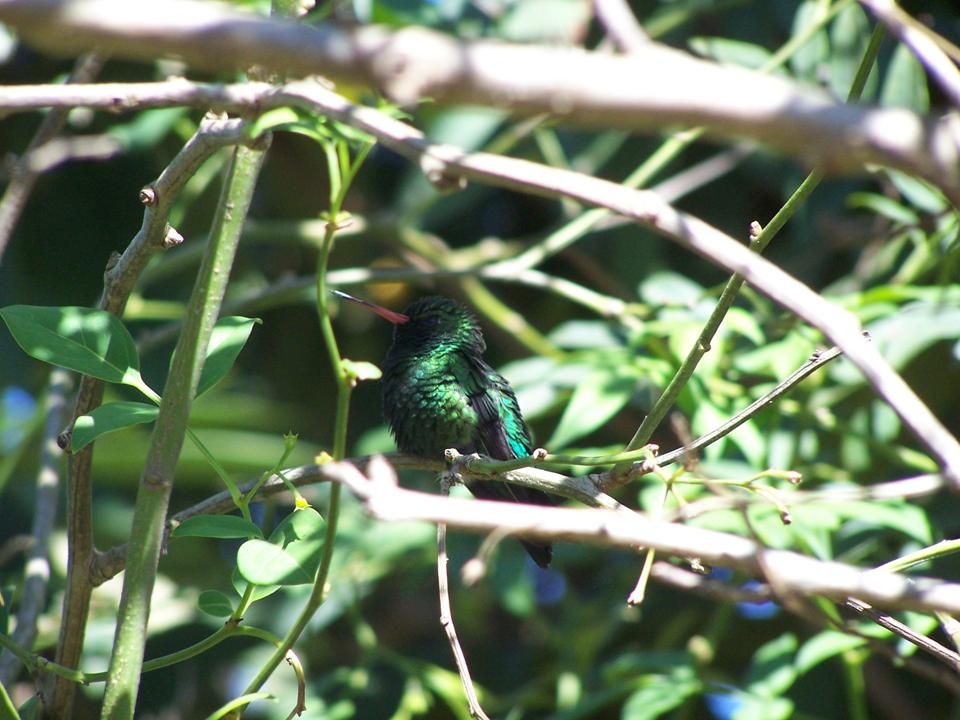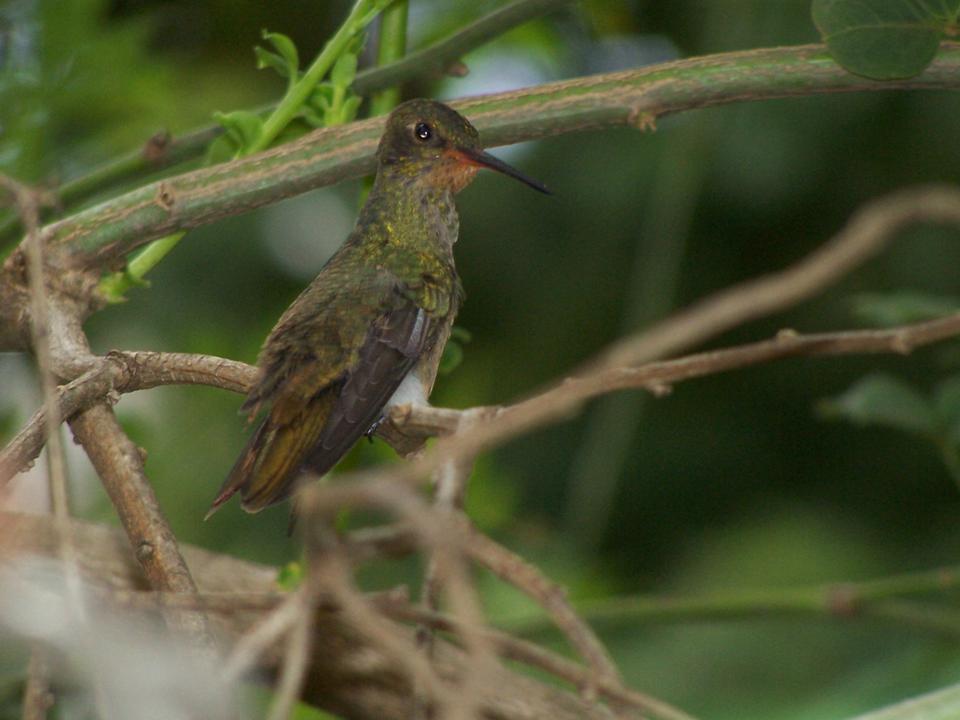
PROLONGED AGGRESSIVE TERRITORIAL ENCOUNTER BETWEEN TWO HUMMINGBIRD SPECIES - A SHORT NOTE
Paul Smith


FIG 1: Male Glittering-bellied Emerald Chlorostilbon aureoventris (Photo Paul Smith)
Despite their diminutive stature, hummingbirds are notoriously antisocial and aggressive birds, with most aggressive behaviour aimed at ensuring an adequate supply of nectar and both sexes defending feeding territories (Williamson 2001). Predictably, the higher the quality of the food resource, the greater number of intruders it will attract (Marchesseault & Ewald 1991, Powers & McKee 1994). Its defence thus comes with a “cost of engagement” (Dearborn 1998) and to be worth defending the yield of the resource must cover the energy deficit incurred in its defence (Brown 1964). Camfield (2006) demonstrated experimentally that Rufous Hummingbirds in Colorado, USA defended higher yield food resources more aggressively than they did lower yield resources, and that displacement of a smaller hummingbird by a larger species (Rufous displacing
Broad-tailed Hummingbirds) from high quality resources was not uncommon, the smaller species being reduced to defending suboptimal territories. On 1 May 2006 in an urban garden (Encarnacion, Departamento Itapúa) I witnessed an extended aggressive encounter between a territorial male Glittering-bellied Emerald Chlorostilbon aureoventris (Fig 1) and a trespassing Gilded Sapphire Hylocharis chrysura (Fig 2), which resulted in the larger invading Sapphire usurping the smaller male Emerald as territory holder.
During previous days of sporadic observation the Emerald had been seen to respond aggressively to the presence of other hummingbirds (both conspecific and allospecific) within the presumed territorial boundaries, calling rapidly and performing swift pursuit flights to drive away intruders. In fact a large percentage of its daily time budget appeared to be devoted to vigilance behaviours. At approximately 11am on the morning in question the presence of a Gilded Sapphire within the territory provoked the predictable aggressive reaction from the Emerald, but rather than fleeing, the Sapphire responded to the attacks with retaliatory aggression - it mounted the Emerald and drove it to ground, pecking at the smaller bird´s head in an extraordinarily vicious display which ceased only when the two birds became aware of my presence. Over the next two hours I then witnessed a prolonged period of two-way aggression as the Emerald tried desperately to eject the larger Sapphire from its territory, while the invader became increasingly determined to make the territory its own.
FIG 2: Adult Gilded Sapphire Hylocharis chrysura (Photo Paul Smith)

The source of the conflict was a small flowering bush of unidentified species approximately two metres high which lay within the “territory” of the Emerald but at which the Sapphire was trying to feed. Although there were several flowering bushes within the territory and hence no shortage of food, this bush appeared to be particularly attractive to the hummingbirds - presumably due to a high nectar yield. As the Sapphire fed it was repeatedly bombarded from all angles by the Emerald, which perched only occasionally to rest, calling loudly in hysterical series of rapid, insect-like tzrt-tzrt-tzrt… calls.
Intermittently the Emerald would rise to a height of approximately five metres, hover briefly and dive-bomb the Sapphire, with audible contact between the two birds, whilst on other occasions the attacks
came from the side, the Emerald swerving suddenly just before contact was made.The Sapphire took the necessary evasive action whilst feeding, only occasionally reacting to chase the Emerald away. Though obviously molested by the unwanted attention, the Sapphire did not attempt to retreat from the territory and continued to feed intermittently at the bush, on each occasion drawing a violent response from the Emerald. When not feeding the Sapphire perched up within two metres of the same bush, and at such times provoked no aggressive response from the territory holder, even though it was in full view. The Sapphire was allowed to feed unmolested at other bushes in the garden, though its repeated returns to the small flowering bush suggested that it was a particularly desirable food source.
After two hours of intermittent attacks by the Emerald, the Sapphire´s responses became increasingly more aggressive. At approximately 2.35pm the Sapphire was seen to pursue the Emerald until the two birds were well out of sight, returning shortly afterwards, though the Emerald was not seen again. The presence of the same Sapphire acting aggressively towards other hummingbirds within the garden over the next few days suggested that it had successfully usurped the Emerald and taken control of the territory.
1. Brown JL 1964 - The Evolution of Diversity in Avian Territorial Systems - Wilson Bulletin 76: p160-169.
2. Camfield AF 2006 - Resource Value Affects Territorial Defence by Broad-tailed and Rufous Hummingbirds - Journal of Field Ornithology 77: p120-125
3. Dearborn DC 1998 - Interspecific Territoriality by a Rufous-tailed Hummingbird Amazilia tzacatl Effects of Intruder Size and Resource Value - Biotropica 30: p306-313.
4. Marchesseault L, Ewald PW 1991 - Effect of Territory Quality on Intrusion Rate in Nonbreeding Hummingbirds - Behavioural Ecology and Sociobiology 28: p305-308.
5. Powers DR, McKee T 1994 - The Effect of Food Availability on Time and Energy Expenditures of Territorial and Non-territorial Hummingbirds - Condor 96: p1064-1075.
6. Williamson SL 2001 - Peterson Field Guides: Hummingbirds of North America - Houghton Mifflin, New York.
Designed by Paul Smith 2006. This website is copyrighted by law.
Material contained herewith may not be used without the prior written permission of FAUNA Paraguay.
Photographs on this web-site were taken by Paul Smith, Hemme Batjes, Regis Nossent,
Alberto Esquivel, Arne Lesterhuis, José Luis Cartes, Rebecca Zarza and Hugo del Castillo and are used with their permission.



